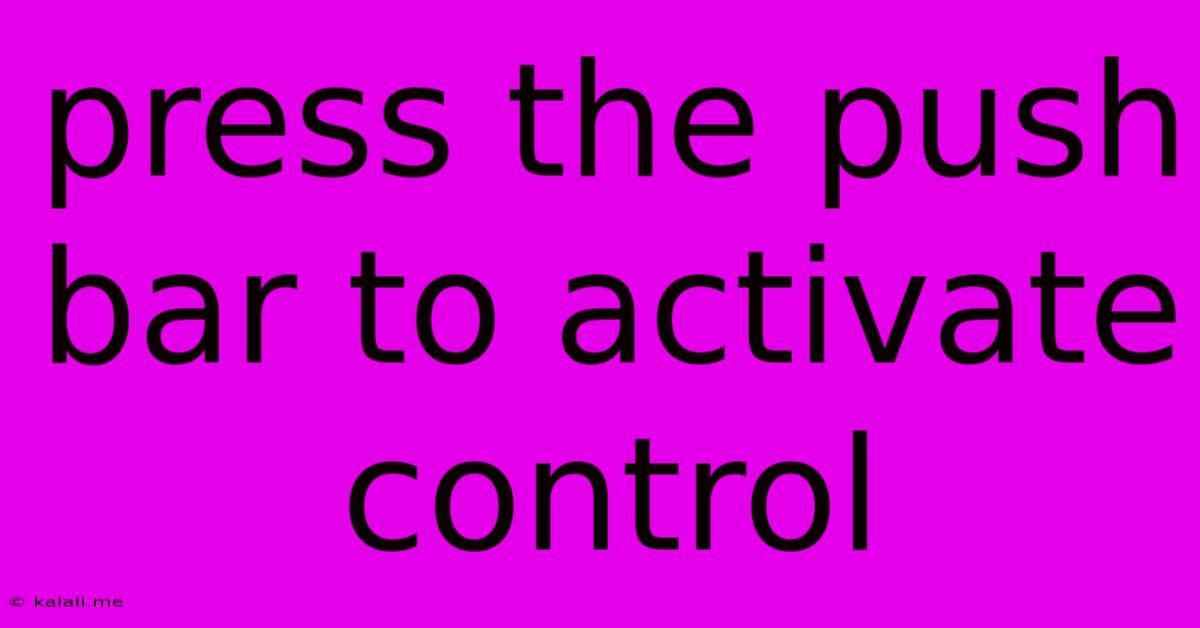Press The Push Bar To Activate Control
Kalali
May 25, 2025 · 3 min read

Table of Contents
Press the Push Bar to Activate Control: A Comprehensive Guide
This article explores the functionality and implications of push-bar activation mechanisms, commonly found in various applications requiring controlled access or operation. We'll delve into the mechanics, safety considerations, and diverse applications where this simple yet effective technology plays a crucial role. Think of this as your ultimate guide to understanding the "press the push bar to activate control" instruction.
Understanding Push-Bar Activation Mechanics
At its core, a push-bar activation system is a straightforward mechanism. A bar, lever, or similar component is designed to be pushed or depressed to initiate a specific action. This action might be anything from opening a door or gate to activating a machine or initiating a safety system. The simplicity of the design makes it both reliable and easily understood by users. The force required to activate the bar can be adjusted to suit the application, ranging from a gentle push to a more substantial force, ensuring appropriate safety measures are in place.
The underlying mechanism can vary, but typically involves a simple mechanical linkage. The push action triggers a switch, relay, or solenoid, which then activates the controlled system. This system can be further enhanced by incorporating sensors for additional safety or monitoring.
Safety Considerations and Features
Safety is paramount when using push-bar activation systems. Several features contribute to their safe and reliable operation:
-
Emergency Stop Mechanisms: Many systems incorporate an easily accessible emergency stop button or mechanism, overriding the push-bar activation and immediately halting the controlled process. This is crucial for preventing accidents.
-
Fail-Safe Design: The push-bar system should be designed to revert to a safe state in the event of power failure or malfunction. This might involve automatic locking or disabling of the controlled function.
-
Force Requirements: The force needed to activate the push-bar is carefully calibrated to prevent accidental activation while remaining easily operable by authorized personnel.
-
Clear Signage and Instructions: Appropriate signage clearly indicating the purpose and operation of the push-bar is essential to ensure user understanding and prevent misuse.
Diverse Applications of Push-Bar Activation
Push-bar activation systems find widespread use across numerous industries and applications:
-
Industrial Automation: In factories and industrial settings, push-bars can initiate automated processes, activate machinery, or control conveyor belts, ensuring safe and controlled operation.
-
Access Control: Push-bars are commonly employed in security systems to control access to restricted areas. The action of pushing the bar can unlock a gate, door, or other access point.
-
Emergency Exits: Push-bar systems are often incorporated into emergency exits, providing a simple and reliable means of opening doors during emergencies. The minimal activation force is essential for quick egress.
-
Vehicle Controls: In some specialized vehicles or equipment, push-bars can activate critical functions, such as emergency brakes or hydraulic systems.
-
Safety Systems: Push-bars play a critical role in various safety systems, initiating alarms, activating safety interlocks, or triggering emergency shutdowns.
Choosing the Right Push-Bar Activation System
When selecting a push-bar activation system, several factors should be considered:
-
Application Requirements: The specific needs of the application will dictate the required force, durability, and safety features.
-
Environmental Conditions: The system should be designed to withstand the environmental conditions it will be exposed to (temperature, humidity, etc.).
-
Compliance and Standards: The system must comply with relevant safety standards and regulations.
-
Maintenance and Reliability: Easy maintenance and a robust design are crucial to ensure long-term reliable operation.
In conclusion, "press the push bar to activate control" is more than a simple instruction; it represents a reliable and widely-used mechanism that plays a vital role in various safety-critical and controlled-access applications. Understanding its mechanics, safety implications, and diverse uses is crucial for anyone interacting with such systems.
Latest Posts
Latest Posts
-
Reinforcement Learning State Parametrizationand Action Parametrization
May 25, 2025
-
How Do I Remove A Kwikset Deadbolt
May 25, 2025
-
How To Tell If Timing Belt Is Bad
May 25, 2025
-
How To Cap A Sprinkler Head
May 25, 2025
-
Unexpected Method Appcast Called On Cask
May 25, 2025
Related Post
Thank you for visiting our website which covers about Press The Push Bar To Activate Control . We hope the information provided has been useful to you. Feel free to contact us if you have any questions or need further assistance. See you next time and don't miss to bookmark.